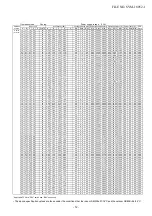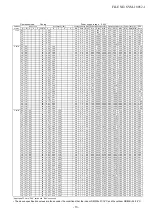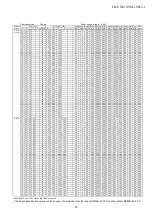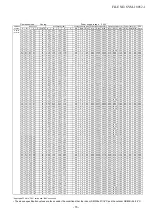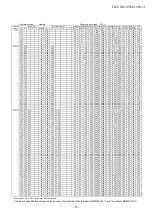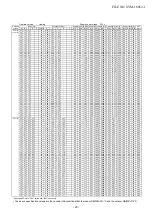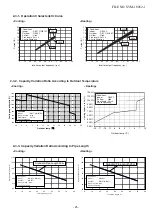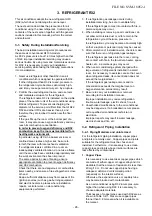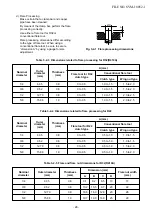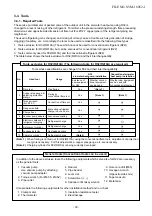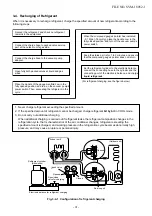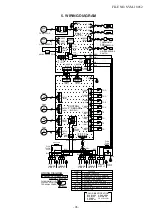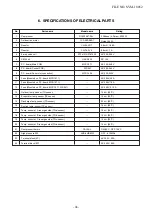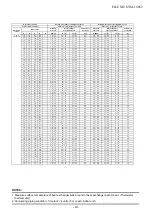
3. REFRIGERANT R
32
This air conditioner adopts the new refrigerant HFC
(R
32
) which does not damage the ozone layer.
The next section describes the precautions for air
conditioner using the new refrigerant. Conforming to
contents of the next section together with the
general
cautions included in this manual, perform
the correct
and safe work.
3-1.
Safety During Installation/Servicing
The basic installation servicing work procedures are
the same as conventional R410A models.
As R
32
’s pressure is about 1.6 times higher than
that
of R22, improper installation/servicing may
cause a
serious trouble.
By using tools and materi-als exclusive
for R
32
, it is necessary to carry out
installation/
servicing safely while taking the following
precautions
into consideration.
1.
Never use refrigerant other than R
32
in an air
conditioner which is designed to operate with
R
32
.
If other refrigerant than R
32
is mixed, pressure
in
the refrigeration cycle becomes abnormally
high,
and it may cause personal injury, etc. by a
rupture.
2.
Confirm the used refrigerant name, and use tools
and materials exclusive for the refrigerant
.
The refrigerant name R
32
is indicated on the
visible
place of the outdoor unit of the air conditioner using
R
32
as refrigerant.
To prevent
mischarging, the
diameter of the service port
differs from that of R22.
R32 and other HFCs are heavier than air, and
therefore they are inclined to settle near the floor
surface.
If the gas fills up the room or the bottom part of a
room, it may also cause oxygen deficiency and may
reach its combustion concentration.
In order to prevent oxygen deficiency and R32
combustion, keep the room well-ventilated for a
healthy work environment.
In particular, using HFCs in a basement room or
confined area creates a higher risk; be sure to
furnish the room with local exhaust ventilation.
If a refrigerant leak is confirmed in a room an
inadequately ventilated location, do not use a flame
until the area has been ventilated appropriately and
the work environment has been improved.
The same applies in case of brazing, ensure
appropriate ventilation to prevent oxygen deficiency
and R32 combustion.
Check that there are no dangerous or combustible
items nearby, and ensure a fire extinguisher is close
at hand.
Keep a sufficient distance away from causes of fire
(ignition sources) such as gas-burning equipment
and electric heaters in places where installation,
repairs, or similar work on air-conditioning
equipment is performed.
3. If a refrigeration gas leakage occurs during
installation/servicing, be sure to ventilate fully.
If the refrigerant gas comes into contact with fire, a
poisonous gas may occur.
4. When installing or removing an air conditioner, do
not allow air moisture dust or oil to remain in the
refrigeration cycle. Otherwise, pressure in
the refrigeration cycle may become abnormally high
so that a rupture or personal injury may be caused.
5. After completion of installation work, check to make
sure that there is no refrigeration gas leakage.
If the refrigerant gas leaks into the room, coming
into contact with fire in the fan-driven heater, space
heater, etc., a poisonous gas may occur
6.
When an air conditioning system charged with a
large volume of refrigerant is installed in a small
room, it is necessary to exercise care so that,
even
when refrigerant leaks, its concentration
does not
exceed the marginal level.
If the refrigerant gas leakage occurs and its
concentration exceeds the marginal level, an
oxygen starvation accident may result.
7.
Be sure to carry out installation or removal
according to the installation manual.
Improper installation may cause refrigeration
trouble, water leakage, electric shock, fire, etc.
8.
Unauthorized modifications to the air conditioner
may be dangerous.
If a breakdown occurs
please
call a qualified air conditioner technician
or
electrician.
Improper repair's may result in water leakage,
electric shock and fire, etc.
3-
2. Refrigerant Piping Installation
3-2-1. Piping Materials and Joints Used
For the refrigerant piping installation, copper pipes
and joints are mainly used. Copper pipes and joints
suitable for the refrigerant must be chosen and
installed. Furthermore, it is necessary to use clean
copper pipes and joints whose interior surfaces are
less affected by contaminants.
1. Copper Pipes
It is necessary to use seamless copper pipes
which
are made of either copper or copper alloy
and it is
desirable that the amount of residual oil
is less than
40 mg/10 m. Do not use copper
pipes having a
collapsed, deformed or discolored
portion
(especially on the interior surface).
Otherwise, the expansion valve or capillary tube
may become blocked with contaminants.
As an air conditioner using R
32
incurs pres-sure
higher than when using R22, it is necessary
to
choose adequate materials.
Thicknesses of copper pipes used with R
32
are
as
shown in Table 3-2-1. Never use copper
pipes
thinner than 0.8 mm even when it is
available on
the market.
FILE NO. SVM-18052
-1
- 26 -

